Digital fabricaton by multi-materials additive manufacturing 4D-Printing

The Freiburg 3D Printing Alliance (F3D), coordinated by the Freiburg Materials Research Centre (FMF), represents a platform for Additive Manufacturing, 3D/4D Printing and materials systems development. The F3D Alliance brings together Freiburg's core competences in the fields of materials research, microsystems technology, biology, polymer sciences, medicine and computer science in the field of Additive Manufacturing. The F3D Alliance creates a unique knowledge and value chain spanning from material, process and software development, microsystems technology, simulation, modelling to applications in the areas of sustainable lightweight construction, architecture, energy technology, optics, microsystems technology, sports and medicine. The F3D material spectrum ranges from metal and glass to polymers, composites, biological and bio-inspired material systems.
The F3D network includes six faculties of the University of Freiburg (Biology; Chemistry & Pharmacy; Mathematics & Physics; Medicine; Environment and Natural Resources; Engineering), centers and institutes of the University such as the Freiburg Materials Research Centre (FMF), the Centre for Interactive Materials and Bioinspired Technologies (FIT), the Institute for Microsystems Technology (IMTEK), the Institute for Sustainable Technical Systems (INATECH), G.E.R.N. ("tissue replacement, regeneration & neogenesis") of the Freiburg University Clinics, the Freiburg Excellence Cluster "Living, Adaptive and Energy-autonomous Material Systems" (livMatS) and the Freiburg Institutes of the Fraunhofer Society (Ernst-Mach Institute, EMI; Institute for Mechanics of Materials, IWM; Institute for Solar Energy Systems, ISE; Institute for Physical Measurement Techniques, IPM; Institute for Applied Solid State Physics, IAF) and several companies.
The Freiburg 3D Printing Alliance (F3D) creates a competence network in Additive Manufacturing and 3D Printing and builds a bridge between basic and application-oriented research to address the challenges in this rapidly developing high-tech field in close partnership with industry. The F3D Alliance uses and develops extrusion-based Additive Manufacturing, 3D dispensing of one- and two-component systems, drop-on-demand printing of materials and binders, stereolithography, laser sintering, 4D printing, and bioprinting. Additive Manufacturing focuses on the development of sustainable and multifunctional material systems for lightweight construction, bio-functional systems for health care and regenerative medicine, and 3D printing of material systems for energy technology. Special emphasis is placed on multi-material printing to produce unconventional composite materials including novel adaptive and programmable materials, artificial muscles for robotics, vibration and sound absorbers, controllable multidirectional composite materials that are 100% recyclable, 3D-printed batteries, bio-functional material systems, artificial tissue and bio-functional materials tailored to meet the needs of individual patients in medical technologies, pharmacy and regenerative medicine.
The F3D Alliance serves as a platform for the exchange of experience and fosters research and development partnerships in the areas of Additive Manufacturing, 3D/4D printing, multi-material printing and the development of advanced multifunctional multimaterial systems. The F3D Alliance brings together competencies from different disciplines and institutions:
- Broad spectrum of manufacturing processes (SLA, SLM, SLS, FDM, drop-on-demand technology, 3D extrusion, multi-material printing, etc.)
- Broad spectrum of material systems (polymers, glass, ceramics, metal, composites, biomaterials, hydrogels, polyelectrolytes, etc.).
- Competence in tailoring, characterizing, modelling and industrial application of materials and material systems.
- Modelling, simulation, computer design in Additive Manufacturing.
- Interdisciplinary, cross-institutional and cross-national alliance of the University of Freiburg with the Freiburg Fraunhofer Institutes, industry and research institutes of the European metropol region allocated in the Rhine Valley at the Swiss, French, German borders.
- Broad range of applications in industry, biomedicine, clinics.
All those interested in Additive Manufacturing and 3D/4D Printing are cordially invited to join the F3D Alliance.
The F3D Alliance Team Coordinators
Prof. Dr. Rolf Mülhaupt (Freiburg Materials Research Center, FMF, Speaker)
Prof. Dr. Bastian Rapp (Department of Microsystems Engineering, IMTEK)
Dr. Peter Koltay (Department of Microsystems Engineering, IMTEK)
Dr. Klaus Hoschke (Fraunhofer Ernst-Mach Institute, EMI)
Prof. Dr. Christoph Eberl (Fraunhofer Institute for Mechanics of Materials, IWM)
Prof. Dr. Prof. Bernd Rolauffs (Department of Orthopedics and Trauma Surgery, Freiburg University Medical Center & Center for Tissue Replacement, Regeneration & Neogenesis, G.E.R.N.)
Dr. Daniel Biro (Fraunhofer Institute for Solar Energy Systems, ISE)
F3D Alliance Research
- Multidisciplinary design for lightweight construction and 3D printing of metals and structural materials
(Dr. Klaus Hoschke, Fraunhofer Ernst Mach Institute, EMI)
The Ernst Mach Institute fouses on the physics, engineering and computer science of fast-moving processes in experiment and simulation and develops solutions for industrial applications with a focus on reliability, safety, resilience, efficiency and sustainability. With a systemic approach, we consider the entire spectrum from materials and microstructures to complex systems.
The research area Additive Design and Manufacturing at Fraunhofer EMI deals with the design, optimization and mechanics of materials and parts in Additive Manufacturing Modern 3D Printing processes make it possible to process many different materials such as metals, plastics or fiber-reinforced plastics. To exploit the great potential of Additive Manufacturing and bring it into applications, it is necessary to develop design and material concepts tailored to the respective requirements and to combine them with an adapted and resource-efficient process strategy. By applying modern simulation methods in modelling, material engineering and mechanical characterization of material and structure, we develop, for example, complex bionic lightweight construction concepts and integrate new functionalities. In connection with 3D Printing, these enable drastic increases in performance and novel technical product solutions.
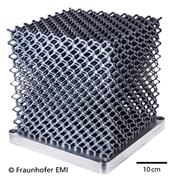
Since 2015, the 3D Printing laboratory center for metals and structural materials at the Fraunhofer EMI in Freiburg has housed the EOS M400, one of the largest commercially available systems for the selective laser melting of metal components. A plant of this size is still unique in the research field in Europe in 2018. The in-house production with state-of-the-art equipment for the 3D printing of metals and fiber-reinforced plastics enables us to support our customers in the entry and application of 3D printing technologies in many areas of product development and to tap new potential.
Foto: Metal components produced by Additive Manufacturing are often limited in size. This highly complex and filigree aluminum structure with an edge length of 40 centimeters, produced with design algorithms and manufactured at the Fraunhofer EMI (©EMI), shows that there exists an alternative route.
- Personalized 3D and 4D printing of programmable and switchable as well as self-regulating multifunctional material systems for sports and medicine
(Prof. Dr. R. Mülhaupt, FMF, Prof. Dr. Th. Speck, FMF, and Prof. Dr. Th. Steinberg, Medicine)
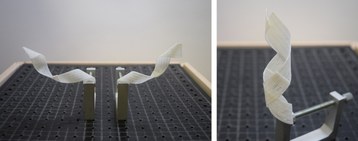
In the 4DmultiMATS research network funded by the Baden-Württemberg Foundation, groups from the fields of bionics and biomechanics (Prof. Dr. Th. Speck, FMF) work together with polymer chemistry (Prof. Dr. R. Mülhaupt, FMF), medicine (Prof. Dr. Th. Steinberg), 3D Printing technology as well as modelling and computer design (Prof. A. Menges, Institute for Computer-Based Design, U. Stuttgart). Through 4D printing, programmable and switchable as well as energy autonomous multifunctional material systems are developed for applications in sports and medicine. The 4D-printed protectors and orthoses adapt their support and protection functions better than previously possible to the current situation of athletes and patients. Precisely fitting 3D/4D-printed passive cooling systems increase the wearing comfort of protectors, exoprostheses, protective vests, bandages and orthoses, support wound healing, e.g. of burns, and prevent skin irritation due to friction. Switchable shape change, contraction/expansion and bonding/debonding on command can greatly facilitate the application and removal of wound covers. The release of drugs like pain relievers and micro biocides, is self-controlled by the 3D structure formation, the degradation of the printed polymer carriers and the switchable absorption/desorption. Minimally invasive 4D-printed wound covers use self-controlled deformation to unfold, adapt to the wound, seal large bone defects and promote tissue regeneration.
- Additive manufacturing of optical glasses and glass-based materials
(Prof. Dr. Bastian E. Rapp, Department of Microsystems Engineering, IMTEK, Chair of Process
Technology)
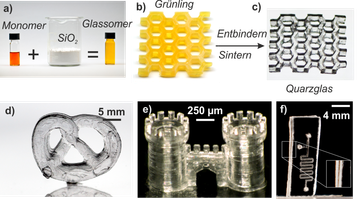
Glass is one of mankind's oldest materials and has been used for thousands of years for all applications that place high demands on optical quality as well as chemical, physical and mechanical strength. Even in the 21st century, glass is one of the most frequently used high-performance materials, for example in optical communications engineering, photonics and medical technology. From decorative objects and sight glasses to containers for liquids, glass is omnipresent as a material. However, plastics are preferred for many applications today. This is mainly since plastics are much simpler in processing technology. The development of scalable industrial molding processes such as injection molding has opened a wide range of applications for plastics. The development of Additive Manufacturing technologies has also made an important contribution here. Plastics are by far the most widely used materials on these platforms. In contrast, the process technology of glass has not changed significantly in almost six centuries. Glass blowing, grinding and chemical/physical etching are still the preferred structuring methods. This has led to glass being used much less frequently than plastics, although it has better properties in many respects.
At the Chair of Process Technology at IMTEK, processes are being developed that allow glass to be structured using Additive Manufacturing (see figure). The basis for this is the patented Glassomer technology. Glassomer is a liquid nanocomposite consisting of monomer and glass nanoparticles, which is liquid even at high solid contents. This material can be structured as an additive because it behaves like a plastic in the process. After structuring, a shaped polymer body is obtained which contains a high proportion of glass nanoparticles. In a next step, the polymeric binder is removed by thermal post-treatment and the resulting glass nanoparticles are compressed into a glass body by sintering.
This process makes it possible for the first time to use glass for the entire range of Additive Manufacturing technologies that were previously only applicable to plastics. Based on pure glass, other glass-based materials and hydride glasses are currently being developed for Additive Manufacturing.
- Printing of liquid metals by StarJet-Technology
(Dr. Peter Koltay, Department of Microsystems Engineering, IMTEK)
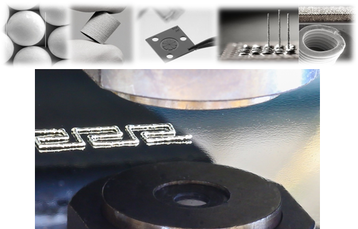
The Start Jet-Technology is a non-contact printing technology that enables printing of molten metal as free flying droplets or jets for 3D-printing and additive manufacturing applications. So far, solders, low melting alloys and aluminum alloys have been successfully printed and tested in various applications. Theoretically, the StarJet technology could enable also printing of higher melting metals such as silver, gold and copper, due to its star shape nozzle and the patented pneumatic actuation principle that can operate at very high temperatures. Such a unique technology, not relying on nanoparticle inks or laser sintering of metal powders, but directly delivery the bulk metal as molten droplets, can be of great benefit for a number of applications in 3D-printing or additive manufacture.
Foto: © Dr. Koltay, IMTEK
- 3D/4D Printing at the Freiburg Plant Biomechanics Group
(Prof. Dr. Thomas Speck, Freiburg Botanical Garden, Biology, Freiburg Materials Research Center, FMF,
and Freiburg Institute for Interactive Materials and Bioinspired Technology, FIT)

For the replication of biological model structures and the construction of bionic demonstrators, the Plant Biomechanics Group uses various 3D/4D printing techniques in addition to the usual methods. Besides Fused Filament Fabrication (FFF) printers, stereolithography (SLA) (envisionTEC Perfactory® 3 MML) and Polyjet printers (Stratasys Objet260 Connex3®) from FIT are used. The Polyjet printer allows to print among other things materials with variable elasticity, whereby a broad spectrum of demonstrators with hard/soft and/or stiff/elastic transitions can be produced.
The 3D printing processes are used in rapid prototyping for molds with complex geometries that could not be produced with other processes. Transparent materials can be used to illustrate complex internal plant structures.
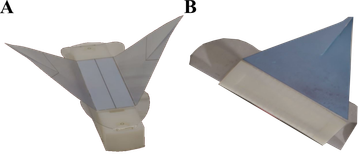
In addition, principle and functional demonstrators such as the backbones of the artificial Venus flytrap for the cluster of excellence "Living, Adaptive and Energy-autonomous Material systems" (livMatS) were produced by 3D Printing.
Foto: Principle and functional demonstrators for the artificial Venus fly trap: A) Pneumatic actuator with 3D printed backbone; B) thermal actuator with 3D printed backbone for swelling and thermal actuation by hydrogels (© Prof. Speck, Biology).
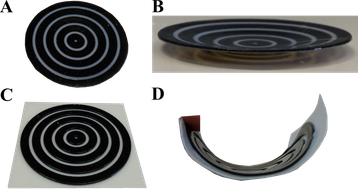
In addition to classic 3D printing, the combination of different materials enables the production of demonstrators with adaptive properties that can react to heat and moisture (4D Printing).
Foto: 4D Printing of demonstrators with material combinations; white material is solid and swells faster than the black flexible material; A) alternating rings dry; B) alternating rings moist with visible change; C) plate with rings on one side dry; D) plate swollen faster than rings, causing bending (© Prof. Speck, Biology).
- Tailoring materials and material systems for Additive Manufacturing
(Prof. Dr. Rolf Mülhaupt, Freiburg Materials Research Centre, FMF)
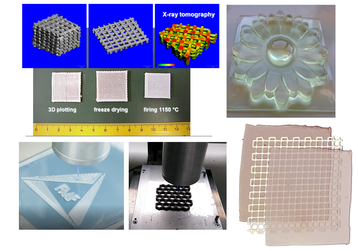
At the Freiburg Materials Research Center (FMF), new materials and material systems are tailored for Additive Manufacturing and made available in kilogram quantities. Research focuses on stereolithography, 3D extrusion and sustainable material systems. In the FMF Scale-up Laboratory, low and high molecular weight materials, functionalized micro- and nanoparticles, biomaterials as well as dispersions, blends and formulations are prepared and characterized. The FMF Service Group Rheology and Polymer Processing analyzes and optimizes the processing behavior and thermal, mechanical and electrical properties of materials. The FMF service group Surfaces and Interfaces uses modern microscopy (TEM, SEM, AFM) to monitor (nano)structure formation and to elucidate structure formation mechanisms on various length scales.
At the end of the 1990s, the FMF developed a versatile 3D micro extrusion process which is the basis of the 3D BioplotterTM introduced to the market by envisionTEC in 2002. The 3D micro extruder is used to 3D print pastes (metal, ceramics, graphene, cellulose, plastics), polymer melts, dispersions, polymer solutions, cement and hydrogel precursors, biomaterials, living cells, reactive resin systems such as acrylates, polyurethanes, silicones and ionomers . This extrusion-based additive manufacturing process is used to produce honeycomb structures from waste paper and pulp suspensions. FMF's tailor-made polyolefin materials are 3d printed using fused filament fabrication to produce dense and porous all-hydrocarbon materials for lightweight construction that are 100% recyclable and equipped with various functions. Polyurethane systems are tailor-made for 3D printing without the use of moisture-sensitive and toxic isocyanates. In the field of stereolithography, formulated resin systems and novel inorganic/organic hybrid materials are being developed and exhibit an attractive balance of improved heat resistance, stiffness, strength, impact strength, electrical conductivity, transparency, flame retardancy and exploit renewable raw resources. Actuators and artificial muscles are manufactured by means of 4D Printing exploiting tailor-made material systems.
- Additive Manufacturing processes and materials for innovative energy storage cells
(Dr. D. Biro, Fraunhofer Institute for Solar Energy Systems, ISE)
The growing use of small autonomous systems in the fields of medical technology and production in industry 4.0 as well as the rapidly growing "Internet of Things" goes hand in hand with the necessity to be able to store and release energy in a small space. In many applications, battery cells already account for more than 20% of the device's volume. This results in new challenges for the integration of battery cells and their production, since encapsulations and connection technologies require a lot of space and the battery cells themselves are manufactured in a very complex process. Additive manufacturing and suitable materials are regarded as predestined technologies for mastering this challenge with high cost-effectiveness and flexibility. With additive manufacturing, the battery cell could be processed directly onto the substrate, which leads to a drastic reduction in process complexity, costs and the required installation space. In the ADDspice project funded by the Baden-Württemberg Foundation, a three-dimensional battery cell architecture is to be implemented using additive manufacturing with electrodes arranged interdigital on one side of a substrate. Accordingly, the battery can also be applied directly to a printed circuit board, smartcard or "lab-on-the-chip" system, so that it is extremely space-saving and can be manufactured with just a few process steps. The aim is to create a new generation of battery cells for a wide range of applications that can be produced at very low cost.
- 3D Bioprinting Network
(Dr. P, Koltay, Department of Microsystems Engineering, IMTEK)
http://www.microtec-suedwest.de/projekte/bmbf-3d-bio-net/3dbionet-projektpartner
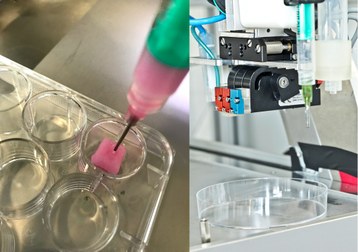
IMTEK has developed several micro dispensing technologies especially suited for printing of cells featuring sterile operation by single use components, high cell viability and special functionalities like single cell printing or drop-on-demand printing of highly dense cell suspensions and spheroids. Using these unique and other established technologies such as micro extrusion printing or fused deposition modelling (FDM), 3D-bioprinting process for printing of artificial tissues and organs are developed. Our interdisciplinary projects span from basic research in collaboration with medical and biological research institutes to applied research with small and medium companies. The overarching aim is to develop generic processes, materials, technologies and workflows to make 3D-bioprinting more flexible, reliable and easy to use, to open perspectives for in-vitro applications as well as future clinical use. Therefore, various applications ranging from vascularized bone tissue replacement to organ-on-chip systems are investigated. These applications are enabled by a new generic 3D-bioprinter based on IMTEKs micro dispensing technologies developed in collaboration with our spin-off company BioFluidix GmbH and other partners of the 3D-Bio-Printing Network.
Foto: © Dr. Koltay, IMTEK
- 3D Printing at G.E.R.N. (Center for Tissue Replacement, Regeneration & Neogenesis)
(Prof. Dr. Anke Bernstein, Prof. Dr. Bernd Rolauffs, Department of Surgery, Clinic for Orthopaedics and
Trauma Surgery and G.E.R.N.), www.gerninfreiburg.de)
Many aspects make 3D Printing interesting for medicine and the life sciences: the process allows the combination of medically interesting materials with new architectural structures, which cannot be realized with other processes or only with considerable additional effort. In addition, the process is modern, fast, relatively inexpensive and allows the user to model and implement the desired models himself using professional CAD software. Until now, 3D Printing has been used in medicine, e.g. for patient care with simple, easy-to-use hand prostheses with gripping function and for the manufacture of surgical instruments or anatomy-individualized templates for intraoperative use.
Soon, image data such as CT images of the skeletal system or tissue ultrasound data could be used to generate individualized, clinically testable 3D objects. These could be further developed into highly specialized, efficient implants which, for example, allow anatomically customized joint replacement with 3D-printed individualized prostheses or highly specialized tissue replacement with cell-inductive, responsive biomaterials. Accordingly, 3D Printing processes that allow additive manufacturing or bioprinting are the subject of intensive research in many modern areas of medicine.
Prof. Bernstein at the G.E.R.N. of the Medical Faculty is involved in a project on the design and manufacture of endoprostheses using electron beam melting (EBM). The aim of this project is the automated realization of patient-specific prostheses or implants by means of modern, computer-supported routines and algorithms through additive-generative manufacturing. On the one hand, individual anatomical conditions of the patient are considered in the best possible way and, on the other hand, aseptic loosening because of postoperative bone remodeling, especially of load-bearing implants, is to be reduced. In this context, additive materials for bone replacement, e.g. based on CaP ceramics, which can be loaded with antibiotics for the treatment of bone infections, or which allow enzymatic mineralization of 3D-printed composites to create stable, resorbable scaffolds for bone replacement, are also to be realized.
Prof. Rolauffs at the G.E.R.N. Faculty of Medicine has the Chair of Tissue Replacement Research and is working on modern implants for the musculoskeletal system. The aim is to produce functionally valuable, clinically useful and regulatory models from the laboratory for the patient. Here, implant models are to be created which integrate defined biophysical properties such as stiffness, surface architecture and transmission of biomechanical forces into cell-controlling stimuli which, after implantation in the patient's body, control cell fate adapted to the specific clinical situation. The 3D print will be used on different scales to produce the basic bodies of such implants and to functionalize surfaces and inner life.
F3D Publications
2017
S.C. Ligon, R. Liska, J. Stampfl, M. Gurr, R. Mülhaupt
Polymers for 3D Printing and Customized Additive Manufacturing
Chemical Reviews 2017, 117, 10212–10290 (free Download)
F3D Media
Innovative material systems for 3D printing – University of Freiburg
At the Freiburg Material Research Center (FMF), researchers in Prof. Dr. Rolf Mülhaupt's group are developing material systems for sustainable lightweight construction, architecture, energy technology, sports, and medicine. The FMF coordinates the Freiburg 3D Printing Alliance (F3D), which combines the fields of materials research, microsystems technology, biology, polymer sciences, medicine and computer science in additive manufacturing. The F3D material spectrum ranges from metal and glass to polymers, composites, biological, and bio-inspired systems for 3D-/4D-printing.
64b6772a2182e1372f765ac0156c37bc
3-D-Drucken - Rolf Mülhaupt
Printing today means much more than just putting letters on paper. With so-called 3-D printers, things can be produced on the spot, which previously had to be laboriously produced by sawing and filing or by injection molding in the workshop. Even edible things are possible. Pioneers of 3-D printing teach and research at the Freiburg Materials Research Center.
3d8b1b02a99d4b859cf5cf0d29efcee0
F3D Contact
Prof. Dr. Rolf Mülhaupt
Phone +49 761 203-6273
E-mail: rolfmuelhaupt(at)web.de
Prof. Dr.-Ing. habil. Bastian E. Rapp
Telefon +49 761 203 7351
E-mail: bastian.rapp(at)imtek.de

